NVIDIA’s GeForce GTX 480 and GTX 470: 6 Months Late, Was It Worth the Wait?
by Ryan Smith on March 26, 2010 7:00 PM EST- Posted in
- GPUs
Temperature, Power, & Noise: Hot and Loud, but Not in the Good Way
For all of the gaming and compute performance data we have seen so far, we’ve only seen half of the story. With a 500mm2+ die and a TDP over 200W, there’s a second story to be told about the power, temperature, and noise characteristics of the GTX 400 series.

Starting with idle temperatures, we can quickly see some distinct events among our cards. The top of the chart is occupied solely by AMD’s Radeon 5000 series, whose small die and low idle power usage let these cards idle at very cool temperatures. It’s not until half-way down the chart that we find our first GTX 400 card, with the 470 at 46C. Truth be told we were expecting something a bit better out of it given that its 33W idle is only a few watts over the 5870 and has a fairly large cooler to work with. Farther down the chart is the GTX 480, which is in the over-50 club at 51C idle. This is where NVIDIA has to pay the piper on their die size – even the amazingly low idle clockspeed of 50MHz/core 101MHz/shader 67.5Mhz/RAM isn't enough to drop it any further.

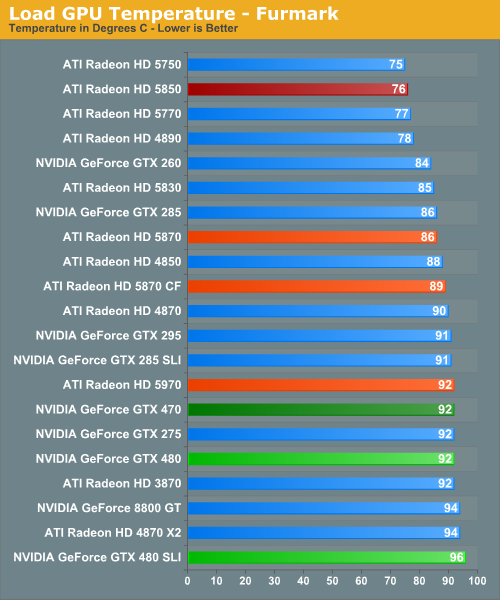
For our load temperatures, we have gone ahead and added Crysis to our temperature testing so that we can see both the worst-case temperatures of FurMark and a more normal gameplay temperature.
At this point the GTX 400 series is in a pretty exclusive club of hot cards – under Crysis the only other single-GPU card above 90C is the 3870, and the GTX 480 SLI is the hottest of any configuration we have tested. Even the dual-GPU cards don’t get quite this hot. In fact it’s quite interesting that unlike FurMark there’s quite a larger spread among card temperatures here, which only makes the GTX 400 series stand out more.
While we’re on the subject of temperatures, we should note that NVIDIA has changed the fan ramp-up behavior from the GTX 200 series. Rather than reacting immediately, the GTX 400 series fans have a ramp-up delay of a few seconds when responding to high temperatures, meaning you’ll actually see those cards get hotter than our sustained temperatures. This won’t have any significant impact on the card, but if you’re like us your eyes will pop out of your head at least once when you see a GTX 480 hitting 98C on FurMark.
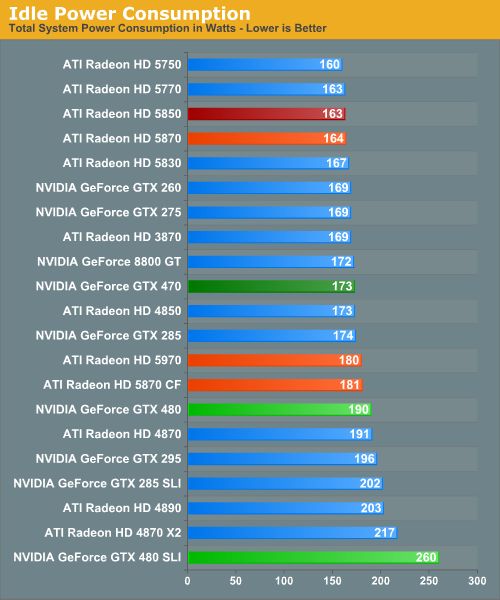
Up next is power consumption. As we’ve already discussed, the GTX 480 and GTX 470 have an idle power consumption of 47W and 33W respectively, putting them out of the running for the least power hungry of the high-end cards. Furthermore the 1200W PSU we switched to for this review has driven up our idle power load a bit, which serves to suppress some of the differences in idle power draw between cards.
With that said the GTX 200 series either does decently or poorly, depending on your point of view. The GTX 480 is below our poorly-idling Radeon 4000 series cards, but well above the 5000 series. Meanwhile the GTX 470 is in the middle of the pack, sharing space with most of the GTX 200 series. The lone outlier here is the GTX 480 SLI. AMD’s power saving mode for Crossfire cards means that the GTX 480 SLI is all alone at a total power draw of 260W when idle.
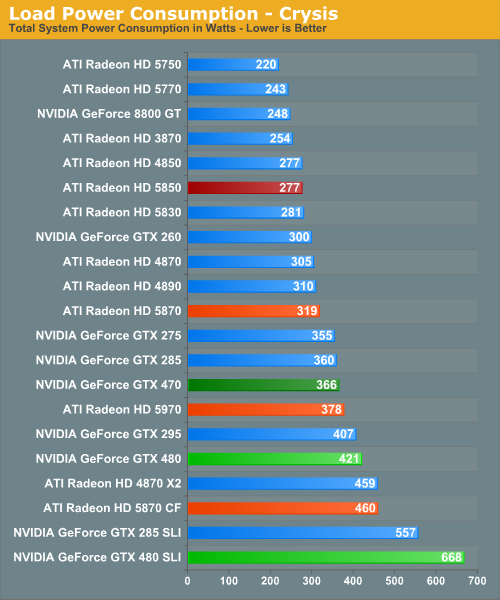
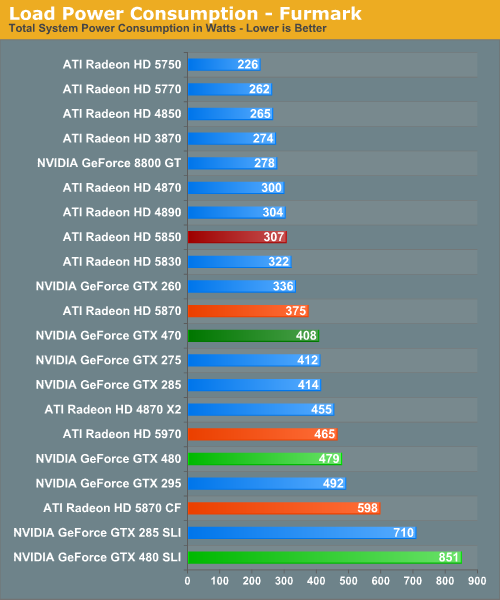
For load power we have Crysis and FurMark, the results of which are quite interesting. Under Crysis not only is the GTX 480 SLI the most demanding card setup as we would expect, but the GTX 480 itself isn’t too far behind. As a single-GPU card it pulls in more power than either the GTX 295 or the Radeon 5970, both of which are dual-GPU cards. Farther up the chart is the GTX 470, which is the 2nd most power draining of our single-GPU cards.
Under FurMark our results change ever so slightly. The GTX 480 manages to get under the GTX 295, while the GTX 470 falls in the middle of the GTX 200 series pack. A special mention goes out to the GTX 480 SLI here, which at 851W under load is the greatest power draw we have ever seen for a pair of GPUs.

Idle noise doesn’t contain any particular surprises since virtually every card can reduce its fan speed to near-silent levels and still stay cool enough. The GTX 400 series is within a few dB of our noise floor here.
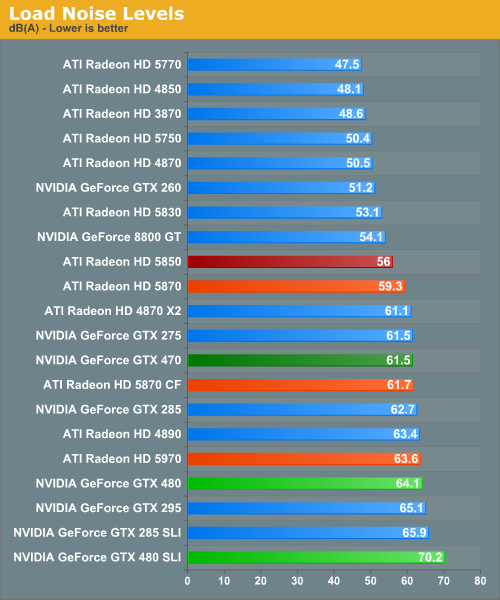
Hot, power hungry things are often loud things, and there are no disappointments here. At 70dB the GTX 480 SLI is the loudest card configuration we have ever tested, while at 64.1dB the GTX 480 is the loudest single-GPU card, beating out even our unreasonably loud 4890. Meanwhile the GTX 470 is in the middle of the pack at 61.5dB, coming in amidst some of our louder single-GPU cards and our dual-GPU cards.
Finally, with this data in hand we went to NVIDIA to ask about the longevity of their cards at these temperatures, as seeing the GTX 480 hitting 94C sustained in a game left us worried. In response NVIDIA told us that they have done significant testing of the cards at high temperatures to validate their longevity, and their models predict a lifetime of years even at temperatures approaching 105C (the throttle point for GF100). Furthermore as they note they have shipped other cards that run roughly this hot such as the GTX 295, and those cards have held up just fine.
At this point we don’t have any reason to doubt NVIDIA’s word on this matter, but with that said this wouldn’t discourage us from taking the appropriate precautions. Heat does impact longevity to some degree – we would strongly consider getting a lifetime warranty for the GTX 480 to hedge our bets.










196 Comments
View All Comments
Ryan Smith - Saturday, March 27, 2010 - link
Yes, we did. We were running really close to the limits of our 850W Corsair unit. We measured the 480SLI at 900W, which after some power efficiency math comes out to around 750-800W actual load. At that load there's less extra space than we'd like to have.Just to add to that, we had originally been looking for a larger PSU after talking about PSU requirements with an NVNDIA partner, as the timing of this required we secure a new PSU before the cards arrived. So Antec had already shipped us their 1200W PSU before we could test the 850W, and we're glad since we would have been cutting it so close.
bigboxes - Sunday, March 28, 2010 - link
Appreciate the reply.GullLars - Saturday, March 27, 2010 - link
OK, so 480 generally beats 5870, and 470 generally beats 5850, but at higher prices, temperatures, wattage, and noise levels. What about 5970?As far as i can tell, the 5970 beat or came even with 480 in all tests, draws less power, runs cooler, and makes less noise. The price isn't that much more either.
It seems more fair to me to compare 480 with 5970 as both are the fastest single-card (as in PCIe slot) sollutions and are close in price and wattage.
I would also like to see what framerate FPS games come in at with gamer settings (1680x1050 and 1920x1200 resolutions), and if average is higher than game cutoff or tickrate, what is the minimum FPS, and how much can you bump eyecandy before avg drops below cutoff/tickrate or minimum drops below acceptable (30).
The reason for gamers sacraficing visuals to get high FPS can be summarized to game flow and latency. If FPS is below game tickrate, you get latency. For many games the tickrate is around 100 (100 updates in the game engine pr second). At 100 FPS you have 10ms latency between frames, if it drops to 50 you have 20 ms, and at 25 you have 40 ms. Lower than 25-30 FPS will obviously also result in virtually unplayable performance since aiming will becoming hard, so added latency from FPS below this becomes moot. If you are playing multiplayer games, this is added to the network latency. As most gamers know, latency below 30ms is generally desired, and above 50ms starts to matter, and above 100ms is very noticable. If you are on a bad connection (or have a bad connection to the server), 20-30ms added latency starts to matter even if it isn't visually notable.
bigboxes - Saturday, March 27, 2010 - link
Anyone else getting that message? I finally had to turn off the 'attack site' option in FF. It wasn't doing this last night. It's not doing it all over AT, just on the GTX 480 article.GullLars - Saturday, March 27, 2010 - link
Here too, it listed among others googleanalytics.com as a hostile site.It was probebly because NVidia wasn't happy with the review XD
(just joking ofc)
chrisinedmonton - Saturday, March 27, 2010 - link
Great article. Here's a small suggestion; temperature graphs should be normalised to room temperature rather than to 0C.GourdFreeMan - Sunday, March 28, 2010 - link
I agree. Temperature graphs should either be normalized to the ambient environment or absolute zero; any other choice of basis is completely arbitrary.Ahmed0 - Saturday, March 27, 2010 - link
Uh oh, my browser just got a heartwarming warning when I clicked on this article, the warning said that it might infect my computer badly and that I should definitely run home faster than my legs can carry.So, whats up with that?
Lifted - Saturday, March 27, 2010 - link
I just got that too. Had to disable the feature in Firefox.NJoy - Saturday, March 27, 2010 - link
well, Charlie was semi-accurate, but quite right =))What a hot chick... I mean, literately hot. Way too hot